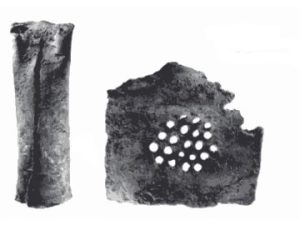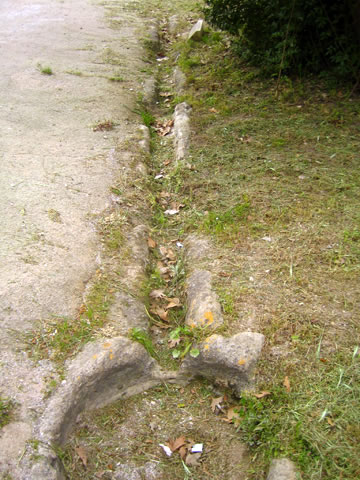Waterworks
Wells
Over four hundred wells have been discovered in the ancient Agora during excavations. In the earliest periods the wells, once opened, were left unlined, while from the 6th century BC onwards, they were occasionally lined with masonry of small stones. Since the 4th century BC the wells were formed with circular terracotta drums in order to create a resistant shaft. The depth of the wells varied from 2,5 m to 37 m, with an average of approximate 10 m. The formation of the mouth of the well also varied in type and dimension. Until the 6th century BC the neck and shoulders of a broken pithos (large jar used for storage) were used, while later drums were specially designed for this purpose, made of terracotta in the beginning, and later of stone. These wellheads often had holes in their walls that were possibly created for the rope which was used to draw water. In this way, it was easier to handle. It is also quite possible that a wooden bar was tied at the end of the rope, permitting the suspension of vessels with food or drink inside the well for refrigeration. On the wellheads of stone there are often marks of the rope as it was drawn over the lip of the well.

Hydria Virtual Museum
During the Hellenistic and Roman times, more sophisticated systems for drawing water were invented. A stone frame above the well would support a pulley. Such wooden pulley wheels have been found in several wells, as well as small pieces of rope. The vessels used for this purpose were mostly made of clay, although in some cases iron-bound wooden buckets have been discovered.

Hydria Virtual Museum
Cisterns in the ancient Agora
In the ancient Agora many cisterns were also found, mostly dating between the 4th – 1st century BC. These are believed to have been of secondary use, in cases when the natural supply of water was not enough. The water from the wells would be used for drinking, while the water stored in the cisterns was normally used for washing. Rainwater was stored in the cisterns after being collected from the surrounding roofs and drained into the rain gutter from the eaves, to end in a canal at ground level leading to the mouth of the cistern. They were relatively small, with a diameter of approximately 3 m, and flask-like in shape, probably in order to avoid the collapse of the rock formations. Frequently, two successive cisterns were connected through a channel, while the walls of the cistern and the channel were covered with a hydraulic mortar. Many vessels have been discovered inside the cisterns that were either accidentally dropped or stored within.

Hydria Virtual Museum
Fountains in the ancient Agora
The ancient Agora also had a variety of Fountain Houses, impressive public constructions for providing water to the citizens and at the same time a meeting point for the women of ancient Athens, who used to gather there in order to draw water.

Hydria Virtual Museum
The southwest fountain dates from the mid-4th century BC and was L-shaped in order to include extensive draw-basins and because of its position at a busy intersection. It was constructed in a period when Athens was suffering from drought, as part of a wider project that intended to provide potable water to the square of the Agora.
This Fountain was completely ruined during the sack of Athens by Sulla (86 BC). As a result only its foundation remains, with very few poros blocks from the superstructure. Its identification as a fountain house results from the discovery of the large stone aqueduct which provided it with fresh water.
The southeast fountain, Enneakrounos (with nine spouts), dates from the second half of the 6th century BC and was canalised from the only existing natural spring of Athens at that time, the Kallirhoe spring. It was the tyrant Peisistratos who diverted the spring waters to the Enneakrounos, with nine faucets inside the fountain house.
Today, this is the best-preserved structure in the south side of Agora. It is an oblong square measuring 6.8 Χ 18.2m. The building originally featured three parts: a central room and two side rooms (aprox. 3.2 Χ 5 m); of these only a few blocks of hard grey limestone survive.
Apart from these two fountain houses there were also fountains near the Bouleuterion (House of Parliament), at the southern end of the Stoa of Attalos terrace and at the back wall of the South Stoa, and also pressure-line fountains to the south of the Tholos and in front of the Bouleutirion.
Hydraulic works
Public works such as aqueducts and drainage systems were also discovered in the ancient Athenian Agora. The earliest of these is a pipeline discovered underneath the east-west road the southern end of the square, dating from the late 6th century BC. It consisted of a series of clay pipes connected to one another from east to west. These pipes fitted into one another by a groove and flange and it is the orientation of this fitting that indicates the direction of the movement of the water, indicated also by the numbering on the clay pipes. It is believed that the pipeline brought water to the Enneakrounos, the Southeast Fountain House of the Ancient Agora and perhaps it is related to the Peisistratid aqueduct that brought water from the springs at the foot of Ymittos Mountain. The date of construction of the works indicates this, and also its position. However, later works interrupted the pipeline, completely eliminating the point of entrance into the Fountain House.
The clay pipes had a hand-hole from which a worker was able to reach in and seal the joint. The whole system was positioned inside a narrow trench that was dug in the ground.
The pipeline consisted of two different series of pipes. One was carefully made, of buff clay, with pipes having oval hand-holes and numbered inscriptions. This numbering of the pipes has two possible explanations. One is that it was used in order to ensure the correct matching of the successive pieces and the other is that it was used to measure the distance of the line, as the length of two successive pipes was very close to two (Greek) feet. However, some pipes were found with their numbers not in the order of the rest of the pipeline.
The second pipeline was less sophisticated, made of grey clay, with square hand-holes and no numbering at all. Instead the name of the maker (i.e. Charon) was etched on them.

Hydria Virtual Museum
Underneath the east-west road a limestone aqueduct was also found, dating from the 4th century BC. It was made of large blocks of soft limestone. The floor blocks are very thick and have a channel of 0.20 m deep in the centre. Ledges were provisioned in these blocks to permit passage by hand. In later times, three terracotta channels were constructed, both to supplement the flow and also to facilitate the distribution of water bringing it to a higher level. The aqueduct ran underneath the middle of the east-west road.
Lead pipes were also used in some cases for the supply of water, but it is believed that it wasn’t preferred by the ancient Athenians, probably because they were aware that it was a material harmful to human health. In addition, the clay pipes were easier to repair and maintain.

Hydria Virtual Museum
Lastly, apart from the hydraulic systems mentioned above, pressure pipes were also used in cases where there was need to transport water uphill or in cases of column fountains. These pipes were thicker and they did not have any hand-holes. The joints were carefully sealed with cement in order to avoid water loss.

Hydria Virtual Museum
Drainage works
Another impressive and sophisticated part of the hydraulic works in the Athenian Agora, were its drainage systems. These systems were used in some cases to deal with the overflow of the fountains. From the Enneakrounos, two waste-pipe lines from two different periods were discovered. The first line consisted of smaller pipes, carefully connected to each other with lids and corresponds to the earliest period of the fountain.

Hydria Virtual Museum
The water collected from this pipeline was used for other, secondary purposes, while later the pipeline was substituted by a new one with larger pipes, similar to the ones of the feed-line. This new hydraulic work was possibly constructed because of the increased overflow of water produced by the construction of the new stone aqueduct mentioned before. In both periods, the two lines from the east and west basin were connected by a Y-shaped pipe that ended in a single pipeline carrying the water to the north. Apart from using these drainage waters for secondary purposes, it is also believed that the waste pipelines of the Enneakrounos finally carried their water to the Eridanos River. This is just one example of the general habit of the Athenians to channel the overflow of the city’s various hydraulic technical works to the rivers and torrents nearby.
Open stone-canals were also used in the Athenian Agora for the overflow of other fountains. Along their course, successive basins were constructed, to collect water which was used for washing and watering of animals and vegetation.
The Great Wastewater Drain
Apart from these solutions for the overflow of the fountains, a wider and more complicated drainage system was constructed in order to collect the waste water from each building. It included many small circular terracotta pipes and open terracotta square channels which all ended in large drains under the streets. The most important of these was the Great Drain, made of walls of masonry combined with ceramic. The Great Drain dates from the early 5th century BC and originally it extended from the area of the Tholos, north of the Agora and beyond to the Eridanos River. Later (late 5th beginning of 4th century BC) the Great Drain was extended to the east and to the west.
The Water clock
Very close to the Southwest Fountain stands the water clock, dating from the mid– 4th century BC, which used flowing water to mark the passage of hours. It is a shaft lined with hydraulic cement which was filled from a reservoir beside the shaft. The water flowed at a regular rate out of the shaft through a metal– lined exit. It is not completely understood how this flow marked the passing of time, but it is assumed that the walls of the shaft were marked at various heights or that a small flag mounted on a float was used.

Hydria Virtual Museum














